Text
Tlanchana

The Tlanchana is an Otomi legend, depicting an enigmatic woman who remains present in many artistic representations to this day.
The legend of the Tlanchana originates from a beautiful Otomi tale from the State of Mexico.
The "sorceress of the lagoon," mother of the fish, Atl tonan Chane, Atlanchane or Tlanchana; has its origins in an ancient legend of the Otomi culture, which has been part of the culture of the State of Mexico, particularly Metepec, for many years. The Tlanchana is a mythological creature whose name comes from the Nahuatl "tlalli," which means earth, and "chana," which translates as woman.
According to the stories told about the Tlanchana, it is said that she was a woman who dwelled in rivers and canals. The National Water Commission (Conagua) states on its blog that the Tlanchana dates back more than 11 thousand years to what was once a lacustrine area full of swamps and nine lagoons guarded by Matlatzinca communities, near Xinantécatl (Nevado de Toluca) and Chignahuapan (Lerma River).
Legend has it that this deity had control over the entire region with her beauty, which dazzled anyone. Although her face, torso, and arms were human, instead of legs, she had a snake tail. It is said that the locals who saw her, hidden behind the tule trees that grew in the lagoon, beheld the beauty of this naked woman who wore a crown and several necklaces, as well as a belt adorned with fish, crayfish, and axolotls.
But the Tlanchana was capricious, possessive, and vengeful. When she was in a good mood, she would flaunt her black snake tail, which was something the fishermen eagerly awaited, as the movement of her tail augured abundance of fish in their nets. However, at other times, the queen would transform her tail into a pair of legs and emerge from the water to seek out the man who had seen her, with the intention of leading him to the middle of the lake where she would drown him.
As the lagoons dried up, fishing ceased, and her appearances gradually became less frequent. However, the legend of the Tlanchana has transcended time, and to this day, it remains an integral part of the identity of Metepec. Moreover, this mermaid has inspired the creation of several museums and cultural exhibitions in Metepec.
That is why today, the master artisans dedicated to pottery are recognized both within and outside the entity for their creations, which help keep cultural traditions alive through artisanal symbols. The Tlanchana, like the Tree of Life, is a clay piece representing the lacustrine area, its form is half fish, with long braids, beautiful complexion, and crowned with flowers.
Read the full article
0 notes
Text
Tlanchana
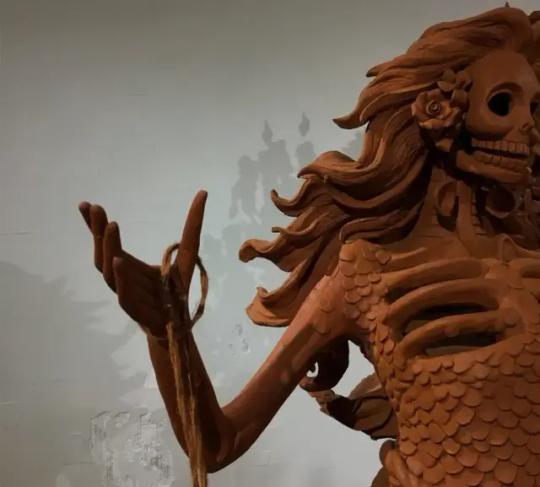
The Tlanchana is an Otomi legend, depicting an enigmatic woman who remains present in many artistic representations to this day.
The legend of the Tlanchana originates from a beautiful Otomi tale from the State of Mexico.
The "sorceress of the lagoon," mother of the fish, Atl tonan Chane, Atlanchane or Tlanchana; has its origins in an ancient legend of the Otomi culture, which has been part of the culture of the State of Mexico, particularly Metepec, for many years. The Tlanchana is a mythological creature whose name comes from the Nahuatl "tlalli," which means earth, and "chana," which translates as woman.
According to the stories told about the Tlanchana, it is said that she was a woman who dwelled in rivers and canals. The National Water Commission (Conagua) states on its blog that the Tlanchana dates back more than 11 thousand years to what was once a lacustrine area full of swamps and nine lagoons guarded by Matlatzinca communities, near Xinantécatl (Nevado de Toluca) and Chignahuapan (Lerma River).
Legend has it that this deity had control over the entire region with her beauty, which dazzled anyone. Although her face, torso, and arms were human, instead of legs, she had a snake tail. It is said that the locals who saw her, hidden behind the tule trees that grew in the lagoon, beheld the beauty of this naked woman who wore a crown and several necklaces, as well as a belt adorned with fish, crayfish, and axolotls.
But the Tlanchana was capricious, possessive, and vengeful. When she was in a good mood, she would flaunt her black snake tail, which was something the fishermen eagerly awaited, as the movement of her tail augured abundance of fish in their nets. However, at other times, the queen would transform her tail into a pair of legs and emerge from the water to seek out the man who had seen her, with the intention of leading him to the middle of the lake where she would drown him.
As the lagoons dried up, fishing ceased, and her appearances gradually became less frequent. However, the legend of the Tlanchana has transcended time, and to this day, it remains an integral part of the identity of Metepec. Moreover, this mermaid has inspired the creation of several museums and cultural exhibitions in Metepec.
That is why today, the master artisans dedicated to pottery are recognized both within and outside the entity for their creations, which help keep cultural traditions alive through artisanal symbols. The Tlanchana, like the Tree of Life, is a clay piece representing the lacustrine area, its form is half fish, with long braids, beautiful complexion, and crowned with flowers.
Read the full article
0 notes
Text
La Llorona

La Llorona, the weeping woman, is a legendary figure deeply ingrained in the folklore of Latin America, particularly in Mexico. This haunting tale has been passed down through generations, evolving into a symbol of tragedy, remorse, and the consequences of one's actions.
Origins of La Llorona: a tragic tale of love and betrayal
The roots of the La Llorona legend can be traced back to pre-Columbian times, blending indigenous mythology with Spanish colonial influences. The most common version tells the story of a beautiful woman named Maria, who falls in love with a nobleman. However, her beloved betrays her for a woman of higher social standing, leaving Maria consumed by grief and rage.
In her anguish, Maria drowns her own children in a fit of madness, only to realize the magnitude of her horrific actions when it's too late. Stricken with remorse, she is condemned to wander the earth, forever searching for her lost children and wailing along riverbanks, earning her the name La Llorona, the weeping woman.
Variations across cultures: La Llorona's global presence
While the core narrative remains consistent, La Llorona has taken on various regional nuances and adaptations as the legend spread across different Latin American countries and beyond. Each culture has added its own twists to the tale, incorporating local folklore and historical events. In some versions, La Llorona is portrayed as a malevolent spirit, while in others, she is a more sympathetic figure, cursed by fate and seeking redemption.
In the United States, La Llorona has become a part of Hispanic-American culture, merging with the broader tapestry of ghost stories and urban legends. The legend has even inspired movies, books, and music, further cementing its place in popular culture.
Cultural significance: La Llorona as a symbol of consequences and warning
The chrcter has transcended its folkloric origins to become a cultural touchstone with profound symbolic significance. The tale serves as a cautionary warning about the consequences of betrayal, especially for women who face societal expectations and struggles. La Llorona embodies the grief of abandoned mothers and the fear of losing one's children, resonating with themes of maternal love, societal expectations, and the consequences of unchecked emotions.
During cultural events and celebrations, the character often takes center stage as a symbol of tragedy and remorse. The legend is a reminder that actions have repercussions, and the haunting cries of La Llorona serve as a chilling refrain cautioning against the perils of unchecked passions.
Enduring impact: La Llorona in modern media and beyond
In the modern era, the personage continues to capture the imagination of people worldwide, finding new life in literature, film, and other forms of artistic expression. Countless books and movies have explored and reimagined the legend, introducing it to audiences who may not have encountered it through traditional storytelling.
Movies like "The Curse of La Llorona" have brought the tale to a global audience, infusing it with elements of horror while preserving its cultural roots. The enduring popularity of the character in various forms of media reflects the timeless allure of this ghostly figure and her ability to evoke deep emotions and contemplation.
La Llorona, with her weeping and haunting presence, remains a powerful and enduring figure in the cultural landscape of Latin America and beyond. As a symbol of love, betrayal, and consequences, her legend continues to captivate audiences, serving as a cautionary tale that transcends borders and generations. Whether whispered around campfires, shared in family gatherings, or depicted in the latest blockbuster, La Llorona's mournful cries echo through time, a poignant reminder of the enduring power of folklore and the timeless lessons it imparts.
Read the full article
0 notes
Text
Cactus Gateway

Already with a few years of existence, Cactus Gateway opens as the neighboring gay resort to CDMX exclusively for men, where clothing is optional, or in other words, nudity is present with all that entails (sex).
It is located in the town of Alpuyeca, municipality of Xochitepec, an hour away from Mexico City, making it a destination designed for weekends of relaxed homosexual eroticism and sensuality with plenty of fantasy possibilities and, above all, guaranteed safety.
The architecture of the space evokes the breezes of a tropical village, and inside it has 14 lodging cabins for two people each, which can be reserved for one or two nights according to preference. Pay attention here: reservations are not exclusive to couples; all types of men are welcome, whether single, married, or smitten.
A normal day involves arriving around 11 am or noon, either with a reserved room — including amenities like coffee, fruits, and sandwiches — or through a day pass that does not include overnight accommodation or meals and drinks. Let's be clear: it is not exactly a cheap destination, but the costs are directly proportional to the quality of the facilities, service, and exclusivity that Cactus Men's Gateway offers. It's worth asking about special packages.
That said, get comfortable showing off your favorite swimsuit and start relaxing in any of its terrace-like areas or wooded paths, although the pool is the most requested when the sun is at its peak, toasting deliciously. As the drinks refresh the afternoon, some guys begin to let loose by taking off their clothes.
The bar service includes beers, spirits such as rum, tequila, and vodka from different brands, and a flirty cocktail menu, in addition to a small but interesting menu of salads, pastas, or sandwiches in case you need to recharge energy. As the crickets make their appearance and the sky darkens, the action concentrates in the jacuzzi, where 30 men can comfortably and playfully enter. There, you can also find tables and spa-like beds. For those with a room, the action extends until the body can handle it.
Cactus Men's Gateway is enjoying a good reception from the community devoted to this type of space, so if you feel like visiting, it's better to start making reservations.
Where: Cactus Men's Getaway Alpuyeca, Morelos.
Phone: 6840 8057.
Price: MEX$ 890-MEX$ 7,299.
Read the full article
0 notes
Text
Most expensive places to live in the country

Mexico City and Querétaro rank among the most expensive places to live in the country, surpassing Milan!
The beautiful Mexico City is a major tourist attraction for both locals and foreigners due to its wide variety of museums, parks, and activities. According to The Economist's Worldwide Cost of Living Index, it is ranked as one of the most expensive cities to live in, surpassing Washington or Milan. It is also deemed the priciest in all of Latin America.
In the ranking, CDMX occupies the 16th position, a significant jump from its previous spot at 76, ascending 60 places in just two years. However, it's crucial to note that this global index considers affordability for foreigners rather than local residents.
What does it mean for CDMX to be one of the most expensive cities to live in?
The ranking measures what can be bought in each city with one dollar. Therefore, the stronger the local currency, the more expensive life will be in that place. Conversely, the weaker the currency, the more accessible life becomes.
The Economist noted in the index that the Mexican peso has strengthened by 15% against the dollar this year, leading to CDMX's rise to the 16th position. Additionally, Querétaro positioned itself as the second most expensive city in the country by climbing 48 places.
Which is the most expensive city to live in worldwide?
Singapore and Zurich hold the top spots as the two most expensive cities to live in, according to the Worldwide Cost of Living Index, both sharing the first position. Zurich, in particular, has been classified as the most expensive place for nine of the last 11 years.
The ranking explains that Singapore ascended due to the Swiss franc appreciating more than 10% against the dollar in the past year. Other cities ranked among the most expensive in the world include Geneva, New York, Hong Kong, and Paris.
Read the full article
0 notes
Text
Bike tour for Valentine's Day
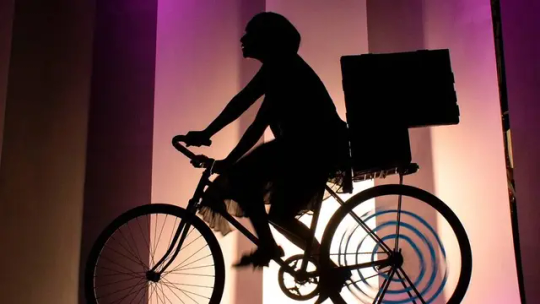
The CDMX organizes a bike tour for Valentine's Day. Free!
Valentine's Day can be an excuse to go on a sweet bike ride with your friends or significant other through the main streets of CDMX, with the moon as the main attraction of the evening.
The Mobility Secretariat (Semovi) of Mexico City announced that the First Night Bike Ride of 2024 will be to celebrate Valentine's Day. It will take place on Saturday, February 24th, from 7 to 11 pm. Although the date is after the celebration, it's never too late for a date outside of restaurants or shopping malls, so take note of the route.
What will be the route of the first Night Bike tour for Valentine's Day 2024?
2024 will kick off with a bang, and you can venture out to take this night ride, as the route will be 20 kilometers! Among the iconic sites you can appreciate are Chapultepec Forest, La Diana Cazadora, the Angel of Independence, the Ahuehuete Roundabout, the Tower of Caballito, as well as other monuments and some points of tourist interest.
Remember that although the event's name implies it's on a bicycle, it's a route that can also be done on skates, a skateboard, or on foot. The goal is to promote a healthy habit among people and have an enjoyable time.
Not only will there be the tour, but Semovi will also prepare a series of cultural and recreational activities for the event, which will be announced — along with the complete route of the ride — in the coming days through its official social media channels.
In past editions, they have had free bike rentals, just make sure to arrive early to avoid a long line and check the requirements for the loan. It's a free event, so don't hesitate to attend with your crush, partner, date, or romantic connection.
Read the full article
0 notes
Text
Christmas
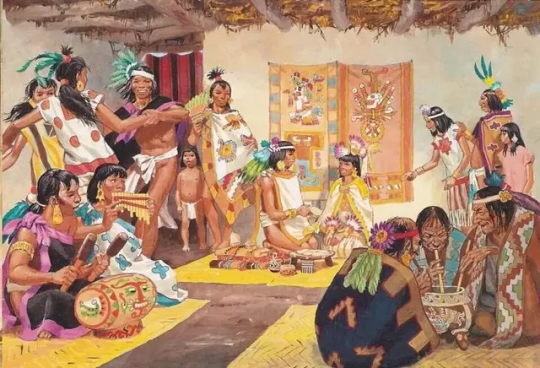
How was 'Christmas' celebrated in the ancient Aztec and Mayan communities?
In America, Christmas was known long after the arrival of the Spaniards, but before that, interesting rituals took place.
Christmas arrived in Mexico with the Spaniards, but what celebration took place in the country before?
Christmas is the main Christian festival, as it marks the birth of Jesus of Nazareth. In fact, the word "Christmas" is derived from the Latin 'nativitas' or birth, and although there is no certainty about the exact date of Jesus Christ in the Middle Ages, the date of December 24 was set so that his followers would move away from pagan celebrations, in this case, linked to the winter solstice and various reasons.
Well, it's for this reason that in 1492 this celebration was not known in America. In fact, it was on December 25 of that same year that the first Christmas was celebrated in Latin America and was called 'La Hispaniola,' the island that currently comprises Haiti and the Dominican Republic, shortly after the Europeans discovered that America existed.
What was celebrated in America, in some communities that make up the territory we now call Mexico, has everything to do with the winter solstice. In fact, it was believed that Huitzilopochtli reached the farthest point from Earth during this period, so he withdrew towards Mictlán, the underworld of the dead, to be reborn on December 24 from the Earth, represented by the goddess Coatlicue, mother of the hummingbird.
This rebirth of the sun occurred in Malinalco, today the capital of the State of Mexico, where celebrations were held to welcome the new cycle. To date, the story of the Mexicas celebrating the birth of Huitzilopochtli, on the same dates that the West celebrates the birth of Jesus, is more or less known. You can read more about it here.
Mayan celebrations
As for the celebration of the Mayans, it is a bit more complex, as they had a deeper knowledge of astronomy, and the Winter Solstice represented the fourth season of the 365-day agricultural year. Thus, the phenomenon of the winter solstice was a great gateway to the spiritual world and the universe, being a day greatly celebrated for the energies emitted on that special day.
The winter solstice indicated the birth of the new sun, the arrival of winter, and the season to let the land rest for its next agricultural cycle. That is why the Mayan cities were built with an orientation, shape, play of light and shadow, and with great precision to know the temporal location of the calendar, with the best example being the Kukulcán pyramid.
Today, you can admire the phenomenon of the winter solstice in some of the most important archaeological sites of Mayan culture on the Yucatán Peninsula such as Chichén Itzá. By observing the west face of the Kukulcán pyramid, you will see the sun rise right at the edge of the building. From three in the afternoon, you will notice that the pyramid "splits" in two: the north and east faces will be in darkness while the south and west faces will be illuminated. This same luminous division of the temples is observed in Uxmal and other sites in Central America.
At the Mayapán archaeological site, as well as in Dzibilchaltún and Oxkintok, what was known as Nitz Upam q'ij paxkua or winter solstice used to be celebrated, according to the website we mayatecu. But as happened with many other celebrations, when the Catholics learned about this festivity, it was prohibited as it was considered a pagan rite, and they gradually established the nativity, building Christian temples over the Mayan temples.
Read the full article
0 notes
Text
Eye wear scam

Eye wear scam: this post is about the real situation which happened to us in the Historic Center.
We have been joyfully walking from Cafe Tacuba, and we were about to cross the street, talking to each other in English. Suddenly at the traffic lights we start to hear screaming and we see an agitated indigenous woman screaming on our son and holding in the hand a pair of broken glasses. She was claiming (in broken English) that our son bumped on her, and knocked out the glasses from her face, then stepped (?) on them.
Glasses, indeed in broken condition.
Then immediately after she starts to request money telling that she just bought those glasses yesterday, and they costed 9000 pesos. And she has an invoice, just in the pocket, how convenient!
In that precise moment I had a sudden warning light lighting in my head:

My RayBans Limited edition costed 300 USD, which is roughly 6000 pesos, and a house maid, badly dressed claims that is able to buy herself glasses for 9000 pesos?
Suddenly out of nowhere a guy appeared, saying that he has an optician shop just nearby and he can fix those broken glasses for around 4000 pesos.
In that moment I got another warning light in my head:

How convenient! Just broken and immediately they will get repaired!
My husband tried to negotiate and politely solve the situation, in Spanish, and we even started to walk in the direction on the optician, then I couldn't ignore warning lights in my head anymore.
I stepped in (I am blond, short hair, very much visible that I am not local). Nobody from the scammers expected that I speak Spanish and I started intensively question the house maid about the glasses, I immediately requested to give them to my hand, so I can assess the brand and the quality of glass. Guess what? She didn't want! Then I started to question her, how come that she can afford such expensive glasses, I basically flooded her with words. She started to back off, and then I requested to go and talk to police.
In that precise moment she turned back, with her fake broken glasses, and started to run away.
So the tourist eye wear scam is as follows:
1. Spot foreigners with kids
2. Pretend that the kid caused a damage
3. Shoot a very high price (maybe the foreigner will give you money right away)
4. If the money hasn't been given, the help (in the person of a handy optician) will arrive and still is the chance to suck half of the given number from the foreigner for the fake reparation
So, beware... and learn Spanish ;-)
Read the full article
0 notes
Text
Beyond Tutankhamun

Beyond Tutankhamun: the immersive experience arrives in CDMX with augmented reality and the entire Egyptian worldview.
Tutankhamun is a mystery. But in this immersive exhibition, you can access information reserved for Egyptologists, as you traverse a 360-degree immersive hall or stroll through the recreation of the boat built to guide the child pharaoh in his journey after death. You will also get to see an exact replica of Tutankhamun's mummy.
This exhibit is part of the 100th-anniversary celebration of the discovery of Tut's tomb, as well as the supposed curse that the press and cinema heavily publicized throughout the 20th century, which has permeated popular culture and the collective imagination.
Additionally, this fascinating exhibition features several replicas of instruments exhibited in the Egyptian Museum in Cairo and the opportunity to enter an exact replica of Tut's tomb and see the famous dagger made from meteorite stone. This exhibit will be divided into 11 rooms to learn all about Egypt's worldview and Tutankhamun, as well as its gods and funerary rituals—one of the pillars of Western culture.
Eleven containers have already arrived in our country with the material that will be exhibited in Beyond Tutankhamun. Work is underway on a three-dimensional replica, over 2 meters tall, of Pharaoh Tutankhamun's death mask.
You will be able to see replicas of more than 5,300 objects found in the intact tomb discovered in 1922 in the Valley of the Kings in Egypt, by the British archaeologist Howard Carter and George Herbert, Lord Carnarvon. The museological concept in Mexico will be first-class, with the possibility of using virtual and cinematographic technology for it.
Beyond Tutankhamun has exclusive documentation from National Geographic, reminding visitors that there are many other exhibitions worldwide about the young pharaoh. It offers virtual reality of the Valley of the Kings, the pyramids of Egypt, and the Sphinx, leading up to Tutankhamun's tomb. Visitors will enter each of the chambers and observe these more than 5,000 articles of the trousseau while seated comfortably in state-of-the-art chairs for that effect, accompanied by spectacular sound.
Beyond Tutankhamun: The Immersive Experience
Where: Specially created tent at the Monumento a la Madre; Insurgentes and Sullivan.
When: From December 15th until May 16th, 2024
Cost: Starting from $470 - Experience with augmented reality $550 pesos
Tickets
Read the full article
0 notes
Text
Seven days in Mexico City

Seven days in Mexico City: to do the best use of your time:
Day 1
A lot of people will tell you to take it easy on your first day, but usually, people arriving in Mexico City are too excited to stay still.
We've planned your first day around a trip to the city center. And there are dozens of ways to do it.
Just walking through Mexico City's Historic Center offers you many options.
Most people will start in the Zócalo area.
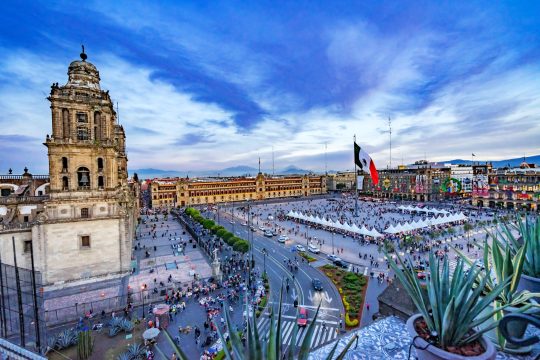
Don't miss the Templo Mayor Museum.
From there, walk west along Avenida Madero. There's a lot to see along the way.
You'll end up at the Palacio de Bellas Artes and the area of Alameda Central.
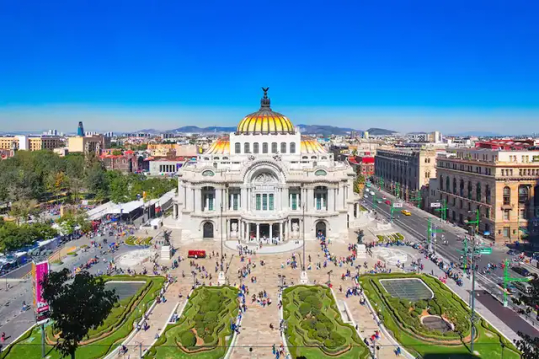
Those truly inspired will then head south to the San Juan Moyotlan neighborhood.
By finishing at the Ciudadela Market, you'll get to see some of the products reflecting Mexico City's strong artistic and artisanal culture.
Day 2
The second day is dedicated to Coyoacán.
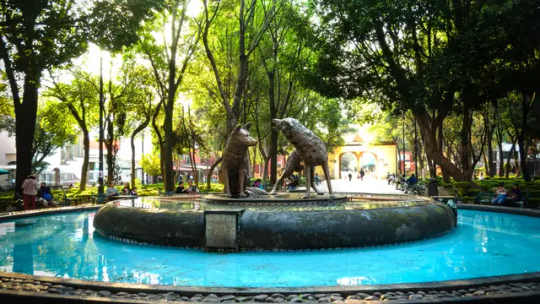
For many visitors to Mexico City, there's no better reason to be in the city than Frida Kahlo, and it's the neighborhood where she lived and died that we'll head to today.
Coyoacán is globally known for its charm. Its streets are designed for strolling, which means that even when arriving here by Metro, visitors spend some lovely extra minutes walking along the beautiful tree-lined streets.
For instance, Francisco Sosa Street has the oldest, most imposing, and beautiful ash trees in the city.
Foreign visitors will make their way from the museum to the Historic Center and the Market. Along the way, there's nothing more to do than enjoy the charming cobbled streets and some of the grand houses from when Coyoacán was just a small village.
For those wanting to venture further, head to the Museum of Interventions in the old Churubusco Monastery. And remember, there's a shopping center right above the Coyoacán metro station. So even if you get lost, there are many things nearby to keep you fed and oriented.
Day 3
On Day 3, we aim to reach the globally renowned Xochimilco.

We can start at the Xochimilco light rail station (bottom left on the map). It's easily accessible from the Tasqueña Metro Station on Metro Line 2.
The goal for the day is to spend a few hours on the small boats called 'trajineras' navigating the ancient canals. Not only is it fascinating, but it also requires no effort and can be quite comforting.
The 13 docks are listed here.
Tips and tricks for navigating Xochimilco well: don't haggle; prices are fixed.
Don't miss the chance to walk (not float) through some of the central neighborhoods of Xochimilco. There are 17 beautiful and ancient neighborhoods - the 'Barrios Originarios' - that are increasingly fascinating. You can explore some of them in just ten minutes.
Xochimilco's market dates back to ancient times and is a marvel of food, flavor, and tradition.
Why not end the day at the Xochimilco Archaeological Museum?
Day 4
Your fourth day will be dedicated to Chapultepec and the National Museum of Anthropology.

Prepare to spend a few hours at the Museum of Anthropology. It covers all of Mexico but is surprisingly succinct.
Chapultepec Park is the largest and most important in Mexico City. It's across the street from the museum, but many visitors may also want to know that the park extends along that same street.
Keep in mind that there are many other museums, such as the National History Museum and two prominent art museums, one of which is the Tamayo Museum.
International visitors will seek even more, either heading east along Paseo de la Reforma or north to Polanco.
Both routes are packed with cultural, architectural, and culinary attractions. There's plenty to eat, experience, and enjoy. If you opt for Polanco, you can stroll along one of the most important commercial avenues in the city: Presidente Masaryk Avenue.
Day 5
Ciudad Universitaria (UNAM) is recognized by UNESCO as a World Heritage Site. On this fifth day, that's where we will go.
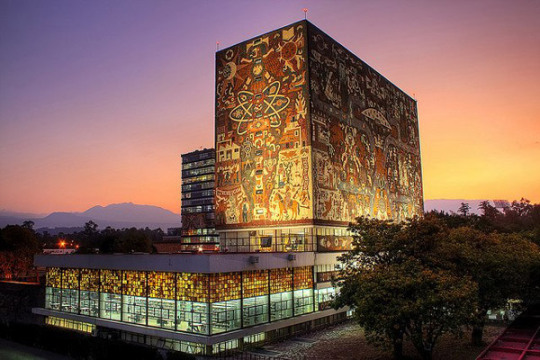
In its construction between 1949 and 1952, more than 60 architects, engineers, and artists participated in a project that, in reality, has never stopped.
Most foreign visitors will want to start at the University Cultural Center. They can get there via the Metrobús (Line 1) at the station of the same name (University Cultural Center).
The more ambitious might want to arrive via the Copilco Metro station, then head south. This route, although much longer, allows for visits to the globally famous Central Library and views of the Rectorate.
These two structures rise above the central campus where the well-known "Islands" and the central gardens of CU are located, designed by the famous Mexican architect Luis Barragán. This magnificent landscape is the everyday backdrop for any UNAM student.
For those not intending to tour Ciudad Universitaria, shorter visits are often combined with excursions to Coyoacán (as suggested on day 2). The Historic Center of Tlalpan and San Ángel are also nearby and are other excellent alternatives.
As a Mexican saying goes, "there's no bad fifth," and this fifth day of the itinerary could very well be the best.
Day 6
Day 6 takes us to the part of Mexico City that has been inhabited for the longest time.
Culhuacán was a city long before Tenochtitlán.
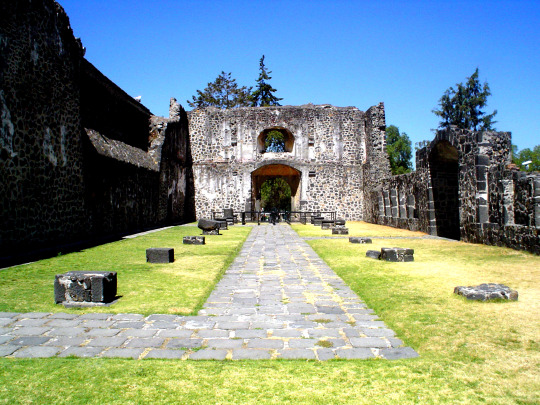
Nowadays, it's more than just the colonial monastery from that era that is also here. Culhuacán is a thriving part of Mexico City shadowed by a mysterious volcano.
At the top, there's a museum about the ancient Ceremony of the New Fire. Centuries of human history are unveiled in a nearby archaeological excavation.
All of this is alongside the famous National Canal. Today, it's a 12-kilometer complex of parks, sports fields, and 18 neighborhoods.
At its southern end, the Canal opens up to the Xochimilco Ecological Park. Less natural but nearby, the new shopping center Parque Antenas is just minutes to the east.
While repairs are underway on Metro Line 12, most visitors will arrive via the Tasqueña Metro.
Day 7
Your last day, it's good to finally see where you've been. The north of Mexico City finally offers exceptional views.
The Basilica of Guadalupe is located at the base of the ancient Tepeyac hill. It was here where the Marian apparitions took place, at least according to legend.

There are a series of architectural wonders. But international visitors might want to climb up to the Cerrito de los Ángeles Chapel. The views are exceptional.
But a cable car ride will give you an even better one. The Indios Verdes Cablebús station is about a 20-minute walk from the Basilica. You'll need a Metro card to board the Cablebús.
Both Cuautepec and the small peak of Tlalpexco Mountain are experiencing a true revival in visitors. You'll be amazed when you arrive.
Read the full article
0 notes
Text
December Celebrations

The December Celebrations 2023 will feature more than 260 daily and free activities in the Historic Center of Mexico City.
The Christmas celebrations in Mexico City are almost here! The Christmas lighting and decoration are also ready to be installed in the Historic Center, consisting of four monumental works located in Government Buildings, Jewelry, and Merchants; a three-dimensional set on Avenida 20 de Noviembre; as well as two luminous mosaics on Avenida Paseo de la Reforma and the Angel of Independence.
To set up all the lighting, 8 thousand LED bulbs, 3 km of garland, 22 km of various colored frost and festoon; 24 km of luminous hoses, and 7.5 km of luminous strips will be used. The work is carried out by 110 workers from the General Directorate of Urban Services, and most of the materials are recycled.
This includes 13 roads adorned with 220,000 poinsettias to kick off the festivities this Saturday, December 9th, with the free performance of the Mexico City Philharmonic Orchestra in the Zócalo, playing pieces like "Swan Lake" and "Sleigh Ride," with over 90 musicians and an expected audience of 10 thousand people, aiming to make music accessible to everyone.
December celebrations in Mexico City's Historic Center
The December Celebrations 2023 include a vast cultural and entertainment offering available throughout December at various venues, primarily at the Zócalo in Mexico City, and most events are free.
Christmas Street Party 2023
The street party will feature 45 artists and musical groups: Pablo Montero, Women of the Flowery Wind, Amandititita, Sonora Propaganda, María Barracuda, Leo Acosta and his Orchestra, La Cruzada from Cuba, Los Músicos de José, Descartes a Kant, Salón Victoria, and Las Guaracheras from Colombia.
Additionally, there will be shepherd's play performances, skill games, a bookstore by Fondo de Cultura Económica giving away copies to families on December 24th, monumental poinsettia trees, illuminated areas for photos, and kinetic lights.
Mexico City Philharmonic Orchestra: December 9th
All about this concert: Free Concert on Zócalo
The Christmas street party
From December 16th to 30th, from 11:00 am to 9:00 pm
Where: Historic Center of Mexico City
When: Daily concerts at 6:00 pm
Free entry
December Celebrations: Poinsettia Festival
This festival includes the participation of 140 floriculturists and agricultural producers from Xochimilco, Milpa Alta, Tláhuac, Magdalena Contreras, Tlalpan, and Álvaro Obregón, expecting an attendance of 250 thousand people and a revenue of 2 million pesos.
Where: Paseo de la Reforma Avenue, between the Estela de Luz and Diana the Huntress
When: Until December 17th, from 10:00 am to 9:00 pm
Free entry
Mexico City Christmas Tourist Festival
This festival will feature the presence of various states of the country promoting tourist destinations in Chapultepec Forest; processions and posadas in the 16 Boroughs; concerts, bazaars, and theatrical performances such as "The Nutcracker," Ballet Folklórico de México by Amalia Hernández in Chapultepec Castle, and "Harry Potter: The Great Winter Ball."
Where: Chapultepec Forest
When: From December 12th to 17th, 2023.
Free entry
Read the full article
0 notes
Text
Trópico 2023 Festival

The Trópico 2023 Festival will be held in Mexico City and will donate all its proceeds to Acapulco.
The Trópico Festival celebrates its tenth anniversary this year, and although it has undergone some changes, the festival continues.
After the passage of Hurricane Otis in Acapulco, the Trópico 2023 festival had to relocate its 10th edition to Mexico City, with the intention of helping the state that has always welcomed them with open arms.
Last September, the Trópico festival revealed the lineup for this year, as well as the ticket sales for the three-day event; however, Acapulco is going through difficult times, and to give back a little of what has been received, the organizers decided to proceed with the event, but this time in Mexico City.
The Trópico 2023 Festival was practically ready to kick off celebrating its tenth anniversary on the coast of Acapulco. However, after Hurricane "Otis" made landfall on October 25th, and the city of Guerrero suffered terrible devastation affecting hotels, tourist centers, and citizens, many events scheduled for the last bimester of 2023 have been postponed.
When and Where will Trópico 2023 be?
The Trópico 2023 festival will take place on Saturday, December 9th, at Parque Bicentenario, located in the Azcapotzalco borough of Mexico City. Additionally, 100% of the proceeds will be donated to help Guerrero through Construyendo, a non-profit organization that promotes solidarity through volunteers supporting construction projects.
Information regarding the lineup after this change, as well as the issue of previously purchased tickets, will be revealed on Wednesday, November 15th, so stay tuned to their social media.
Reportedly, in response to the emergency in Acapulco, the festival will continue but will be reduced to a single day in a venue in Mexico City. For this, it is known that this will be a charity edition, and those who have already purchased their tickets will have two options:
Firstly, they can join Trópico 2023 in support of Acapulco, keeping their valid ticket for the 2023 event, a single-day event in Mexico City. Additionally, they will receive $2,000 for food and beverage consumption within the festival for those who purchased weekend access, or $700 for those who were planning to attend only one day.
The second option is to request a full refund of the ticket price. (Details on how to request it are provided below).
Trópico 2023 lineup
While the festival has announced that the lineup will be different due to the change of venue, it's important to remember who the confirmed artists were to have an idea of what to expect.
The headliners for the 10th edition were the British band Underworld and the Mexican group Café Tacvba. They were followed by Polo & Pan (Playa DJ Set), the iconic 2ManyDjs, Poolside, The XX's member Romy with her solo project, Todd Terje (DJ), and Neil Frances. Representing neighborhood music would be Sonido La Changa and Pablito Mix.
When is Trópico 2023?
During the first days of July this year, Eco, Archipiélago, and Grupo Pegaso, the event organizers, unveiled the dates for the Trópico 2023 Festival, which was planned for December 8th, 9th, and 10th. However, after Hurricane "Otis" devastated Acapulco, the event has changed; now, the festival will take place only on November 9th. And, given the situation, the venue has also been modified.
Where will Trópico 2023 be?
As usual since its debut in 2021, the Trópico 2023 Festival was expected to take place on the coast of Acapulco, Guerrero, the closest beach to Mexico City. But given the current situation in the city, the organizers have changed the venue. For the first time, the Trópico Festival will take place away from the sun and the beach. This time, the venue is the Bicentennial Park in Mexico City.
How much will tickets cost ?
Originally, the ticket prices for Trópico 2023 were as follows, but after the event was reduced to a single day of celebration, there will be new ticketing for the festival's new version.
Phase 1
One Day: 2,900 Mexican pesos
Weekend Access: 4,200 Mexican pesos
Phase 2
One Day: 3,200 Mexican pesos
Weekend Access: 4,600 Mexican pesos
Prices do not include service fees.
Where to buy tickets?
The Boletia portal is responsible for selling tickets for the festival. To access them, you must have an active account, so we recommend creating one before making the purchase.
How to request a refund for your Trópico 2023 ticket?
At the moment, it is only known that those who bought tickets, either for a single day or for the entire weekend of the festival, can request a full refund of the ticket price. However, the details are not yet known. These will be communicated on Wednesday, November 15th. We will update here the method to do so.
Read the full article
0 notes
Text
Free concert in the Zócalo
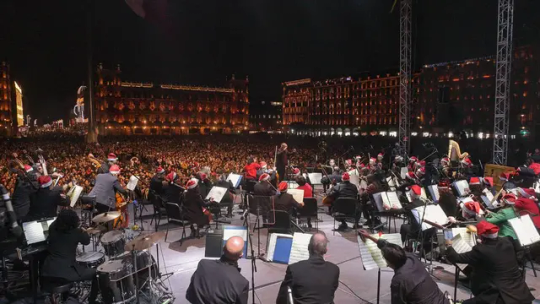
The Mexico City Philharmonic Orchestra will perform a free concert in the Zócalo.
Santa Claus is just around the corner! The Ministry of Culture of Mexico City announced the first Christmas concert in the Zócalo. The best part? Admission will be free.
When will the December free concert in the Zócalo take place?
The event will take place next Saturday, December 9, at 6 pm in the Plaza de la Constitución. The star of the night? The renowned Mexico City Philharmonic Orchestra (OFCM), which will celebrate its 45th anniversary under the direction of the talented Enrique Patrón de Rueda.
Regarding the performance, the OFCM will treat us to a repertoire full of Christmas magic, including classics such as "The Nutcracker" and "Swan Lake" by Pyotr Ilyich Tchaikovsky. In addition, the Philharmonic will perform pieces by Leroy Anderson, such as "A Christmas Festival" and "Sleigh Ride." Obviously, the seasonal favorites will not be missing, such as "White Christmas," "The Little Drummer Boy," and "Adeste Fidelis," in addition to a Christmas Medley.
Keep in mind that during the event, the place will be transformed with a dazzling light show and the traditional Christmas decorations at the National Palace. Snowflake figures and piñatas will shine.
Founded in 1978, the OFCM has international recognition and has performed in the United States, Europe, South America, and Asia. At the same time, it has received awards such as the Oscar from L'Académie du Disque Français and a nomination for the Latin Grammy in the Best Classical Recording category.
All of us from the capital are in a festive mood and traffic is at its peak. So, don't forget to plan your time to arrive early and secure your spot.
Read the full article
0 notes
Text
Christmas Tours in Xochimilco

These two tours in Xochimilco are ideal for spending a day with the best Christmas spirit.
Xochimilco is a place that has everything for spending a Christmas day— a trip in a "trajinera" (traditional boat), lots of poinsettias, great gastronomy, and plenty of things to do and learn. What's more, it offers themed tours that you'll surely love from this destination considered a World Heritage Site.
These Christmas Tours in Xochimilco are designed to experience it all. First, there's the classic ride through the canals on a beautiful trajinera. Then, there's a tasting of typical sweets and a feast of Petit Gateau Café with a Christmas dessert. The visit continues to the "ajolotario" (axolotl sanctuary), where members of the "Pulmón de Villa" pulque bar offer pulque and flavored drinks with seasonal tastes.
While you continue your tour with a glass of pulque in hand, you can visit the poinsettia greenhouse where the Xochimilco floriculturists will explain everything about the origin of this plant, its pre-Hispanic uses, and how to care for it if you decide to buy one.
Finally, there's the Christmas carol concert with local artists that will make you feel the Christmas spirit. As the sun sets, you'll enjoy the return trip with a couple of craft beers from the Xinampa Brewery Group. Remember that this tour is conducted according to demand, so it's essential to have a minimum of 15 people per date.
Where: Cuemanco Pier; Antiguo Canal Cuemanco 105, Pista Olímpica Virgilio Uribe, Xochimilco, CDMX.
When: Saturdays 9th, Sundays 10th, Saturdays 16th, and Sundays 17th of December, starting at 12:45 p.m. until 6:00 p.m. at the same location.
Cost: $1,500 pesos for adults and $1,000 for children aged 5 to 10. Reservation requires a $500 peso deposit, at least 5 days before the experience.
Reservation: (55) 3407 9440.$$
In this other tour full of spirit, you'll find Christmas lights, illuminated figures, a giant tree, as well as a toy factory, and many more surprises. Everything begins at the monumental tree, where there's a giant mailbox for children to leave their letter for Santa Claus.
Where: Xochimilco Ecological Park; Anillo Perif. 1, Col. Ciénega Grande, Xochimilco, CDMX.
When: Until January 9th, from Monday to Sunday starting at 6:30 p.m.
Cost: $120 for children and $150 for adults.
Read the full article
0 notes
Text
Madonna in CDMX

After several delays, the Queen of Pop, Madonna rescheduled her dates in Mexico City from January to April 2024.
In case you were unsure about what to ask from the Three Wise Men in 2024, we can give you an idea because the queen of pop is returning to Mexico City after an eight-year absence to review the hits from her 40-year career in The Celebration Tour.
Madonna is an icon of popular culture. Singer and actress known as the "Queen of Pop," she was born in 1958 in Michigan, United States, rising to fame in the 1980s thanks to her provocative image. With her powerful voice and charisma on stage, she became a pioneer in the pop industry.
Throughout her career, Madonna has released numerous musical hits that have become true classics, including "Like a Virgin," "Like a Prayer," "Vogue," "Hung Up," and "La Isla Bonita." Her songs have been acclaimed for their innovative style and message of female empowerment.
In addition to her music, Madonna has also ventured into cinema, starring in films such as "Desperately Seeking Susan," "Evita," and "Dick Tracy." She has won Grammy Awards, Golden Globes, and collaborated with numerous artists, including Prince, Michael Jackson, Justin Timberlake, Nicki Minaj, Björk, M.I.A., and lately Tokischa.
The Queen of Pop continues to be a legend in the music and entertainment industry. With her tour, The Celebration Tour, in Mexico City on April 20, 21, 23, and 24, 2024, she promises to offer a show that fans will not forget, as it will feature pure hits and top-notch performances.
Address
Palacio de los Deportes
Viaducto Río de la Piedad s/n
Granjas México
México, DF
08400
Price
$1,020-$11,600
Tickets
Read the full article
1 note
·
View note
Text
Christmas tree

If you wish to buy a natural Christmas tree, here are all the options available in the State of Mexico.
Having a natural Christmas tree helps support producers from the State of Mexico, and you can choose it yourself.
We know you're one of those people who love to have a natural Christmas tree since, besides filling the air with a refreshing scent, it provides us with an opportunity to continue the tradition with family and help the farmers from the State of Mexico. That's why we're here to tell you about the most popular places to buy your Christmas tree.
In the State of Mexico, there are over 600 Christmas tree plantations, with approximately 450,000 specimens where producers are dedicated to this plant cultivation. So, there's no excuse; it's essential to consume Mexican products during this December period.
Why choose a Mexican tree?
Firstly, the price. The prices of Christmas trees produced in the state range from $400 pesos to $800 pesos. It's possible that some places may exceed $1,000 pesos due to the tree's height. Regardless of the tree type you choose, you'll always find competitive costs compared to the 2,000 to 3,000 pesos that trees from Canada and the United States cost.
Unlike trees imported from abroad, Mexican trees are of different species; most arrive dehydrated and have been imported to Mexican territory for months, stored in a cold climate, losing branches and leaves during their stay.
It's always better to choose Mexican plants because they provide a fresher, lusher, and greener Christmas space. The experience of choosing your tree, accompanied by your loved ones, visiting a town, and exploring the best parts of the State of Mexico adds to the charm.
Where can I buy my natural Christmas tree?
The localities in the State of Mexico where you can acquire a beautiful Christmas specimen are:
Amecameca
Almoloya de Juárez
Calimaya
Isidro Fabela
Juchitepec
Tlalmanalco
Tenango del Valle
Temascaltepec
Valle de Bravo
Villa del Carbón
Villa Victoria
Xalatlaco
Xonacatlán
Zinacantepec
Many people choose to buy at "La Cuesta" in Xonacatlán. In this plantation, there are over 150 hectares to plant Christmas trees. Species produced in the State of Mexico include Mexican white pine (Pinus ayacahuite), sacred fir (Abies religiosa), and Douglas fir (Pseudotsuga menziesii).
In these areas, they promote the growth of natural areas, sustainability, and economic development based on the utilization of environmental resources.
Read the full article
0 notes
Text
The Aztec Calendar
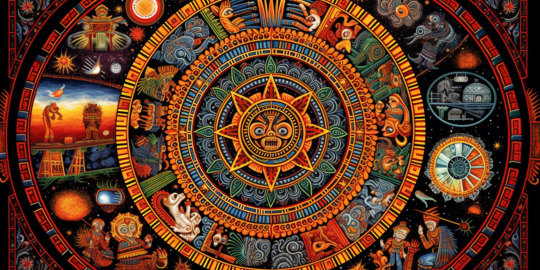
The Aztec civilization, renowned for its rich cultural heritage and sophisticated understanding of astronomy and timekeeping, left behind a monumental relic that continues to captivate the world: the Aztec Calendar Stone, often referred to as the Sun Stone.

Symbolism and design
Crafted from a single massive block of basalt, the Aztec Calendar Stone measures approximately 12 feet in diameter and weighs around 24 tons. Its intricate design symbolizes the Aztec cosmos and their understanding of time. The central motif features the face of the sun god Tonatiuh, adorned with solar rays representing the five world ages or suns according to Aztec mythology.
Radiating outwards from the central deity are highly detailed concentric circles, each depicting various cosmic elements, such as symbols representing days, months, and cycles. These circles illustrate the tonalpohualli (a 260-day ritual calendar) and the xiuhpohualli (a 365-day agricultural calendar), crucial components of the Aztec calendar system.
The Aztec Calendar: cosmic significance
The Aztec Calendar Stone served as a representation of the universe and the cyclical nature of time. It was believed that the cosmos underwent a series of world ages, or suns, each ending in destruction. Tonatiuh, the sun god at the center of the stone, was associated with the fifth and final sun, indicating the present era according to Aztec cosmology.
Moreover, the intricacies of the stone's design provided a visual representation of the Aztec understanding of the passage of time, the importance of celestial bodies, and the interconnectedness of life, religion, and the cosmos.
Cultural legacy
Beyond its astronomical significance, the Aztec Calendar Stone held immense cultural importance. It played a crucial role in religious ceremonies, providing guidance for rituals and festivals. Additionally, it served as a symbol of authority and power for the Aztec rulers, reflecting their connection to cosmic forces and divine legitimacy.
Despite the Spanish conquest and subsequent attempts to suppress indigenous cultures, the Aztec Calendar Stone survived, becoming an enduring emblem of Mexico's pre-Hispanic heritage. Today, it stands as a testament to the artistic brilliance, scientific acumen, and spiritual beliefs of the Aztec civilization.
In conclusion, the Aztec Calendar Stone remains an enigmatic and revered artifact, offering a glimpse into the complex worldview, celestial knowledge, and cultural richness of the Aztec people. Its enduring legacy continues to inspire awe and fascination, preserving the ancient wisdom of a civilization deeply intertwined with the mysteries of time and the cosmos.
The Mayan and Aztec calendars are both significant Mesoamerican systems of timekeeping, but they have distinct differences in their structure, symbols, and cultural significance.
Mayan Calendar:
1. Structure: The Mayan calendar was a complex system that consisted of multiple interlocking cycles. The most renowned was the Long Count Calendar, featuring cycles such as k'in (day), winal (20 days), tun (360 days), k'atun (7,200 days), and b'ak'tun (144,000 days).
2. Symbols: Mayan calendar glyphs and symbols were often inscribed on stelae, monuments, and codices. They were elaborate and detailed, representing specific days, months, and years within the various cycles of the calendar.
3. Cultural Significance: The Mayan calendar had a significant cultural and religious importance. It was used not only for timekeeping but also in religious ceremonies, agricultural planning, governance, and prophecy. The calendar was closely tied to Mayan mythology and cosmology.
Aztec Calendar:
1. Structure: The Aztec calendar, known as the Sun Stone or the Stone of the Sun (often mistaken as the Aztec Calendar), was a circular stone carving. It had two main components: the tonalpohualli (260-day ritual calendar) and the xiuhpohualli (365-day agricultural calendar). The tonalpohualli was formed by combining 20 symbols with 13 numbers, resulting in a 260-day cycle.
2. Symbols: The Aztec Sun Stone, or the Calendar Stone, was a famous monumental sculpture with intricate carvings representing various deities, celestial bodies, and cosmological concepts. It didn't have glyphs for each specific day but was more symbolic in nature.
3. Cultural Significance: The Aztec calendar, like the Mayan calendar, held great cultural significance. It influenced religious ceremonies, rituals, and festivals. The structure of the calendar played a crucial role in determining auspicious days for events like sacrifices, religious ceremonies, and agricultural activities.
While both the Mayan and Aztec calendars were essential for timekeeping and had religious and cultural significance, they differed in structure, symbols, and their specific applications within their respective societies. The Mayan calendar was more intricately detailed and had multiple cycles, while the Aztec calendar was symbolically rich and had a strong emphasis on ritual and agricultural cycles.
Read the full article
0 notes